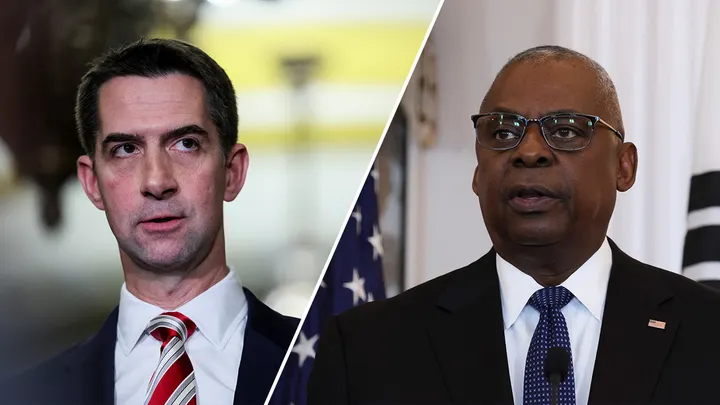- Joe Biden hailed the announcement as ‘historic progress’ on climate change
The Biden administration unveiled drastic climate regulations Wednesday designed to phase out gas cars and ensure the majority of passenger vehicles and light trucks sold in the U.S. by 2032 are electric or hybrid.
It represents one of the most significant parts of its ambitious climate agenda with tight rules on tailpipe emissions.
But in a concession to automakers and labor unions the regulations will be rolled out more slowly than originally proposed.
The rules come as sales of electric vehicles, which are needed to meet the standards, have begun to slow.
‘Three years ago, I set an ambitious target: that half of all new cars and trucks sold in 2030 would be zero-emission,’ said President Joe Biden. ‘Together, we’ve made historic progress.
‘Hundreds of new expanded factories across the country. Hundreds of billions in private investment and thousands of good-paying union jobs. And we’ll meet my goal for 2030 and race forward in the years ahead.’
The rules come as sales of electric vehicles, which are needed to meet the standards, have begun to slow.
‘Three years ago, I set an ambitious target: that half of all new cars and trucks sold in 2030 would be zero-emission,’ said President Joe Biden. ‘Together, we’ve made historic progress.
‘Hundreds of new expanded factories across the country. Hundreds of billions in private investment and thousands of good-paying union jobs. And we’ll meet my goal for 2030 and race forward in the years ahead.’
The auto industry cited lower sales growth in objecting to the EPA´s preferred standards unveiled last April as part of its ambitious plan to cut planet-warming emissions from passenger vehicles.
The EPA said that under its final rule, the industry could meet the limits if 56 percent of new vehicle sales are electric by 2032, along with at least 13 percent plug-in hybrids or other partially electric cars, as well as more efficient gasoline-powered cars that get more miles to the gallon.
The new standards will avoid more than 7 billion tons of planet-warming carbon emissions over the next three decades and provide nearly $100 billion in annual net benefits, the EPA said, including lower health care costs, fewer deaths and more than $60 billion in reduced annual costs for fuel, maintenance and repairs.
The EPA rule applies to model years 2027 to 2032 and will significantly reduce emissions of planet-warming greenhouse gases, as well as other air pollution such as nitrogen oxides and particulate matter from new passenger cars, light trucks and pickups.
The rule will help ‘tackle the climate crisis’ and result in widespread reductions in air pollution while accelerating the adoption of cleaner vehicle technologies, the EPA said. The agency is finalizing the rule as sales of clean vehicles, including plug-in hybrid and fully electric vehicles, hit record highs last year.
The new rule slows implementation of stricter pollution standards from 2027 through 2029, after the auto industry called proposed benchmarks unworkable.
The rule ramps up to nearly reach the level the EPA preferred by 2032.
‘Let me be clear: Our final rule delivers the same, if not more, pollution reduction than we set out in our proposal,” EPA Administrator Michael Regan told reporters. In addition to carbon pollution, the final standards also will reduce other serious air pollution that contributes to heart attacks, respiratory illnesses, aggravated asthma and decreased lung function, Regan said.
‘Folks, these new standards are so important for public health, for American jobs, for our economy and for our planet,’ he said.
The standards are designed to be technology-neutral and performance-based, Regan said, giving car and truck manufacturers the flexibility to choose pollution-control technologies that are best suited for their customers while meeting environmental and public health goals.
The changes appear aimed at addressing strong industry opposition to the accelerated ramp-up of EVs, along with public reluctance to fully embrace the new technology. There is also a legitimate threat of legal challenges before conservative courts.
The Supreme Court, with a 6-3 conservative majority, has increasingly reined in the powers of federal agencies, including the EPA, in recent years. The justices have restricted the EPA´s authority to fight air and water pollution – including a landmark 2022 ruling that limited the EPA´s authority to regulate carbon dioxide emissions from power plants that contribute to global warming.
President Joe Biden has made fighting climate change a hallmark of his presidency and is seeking to slash carbon dioxide emissions from gasoline-powered vehicles, which make up the largest single source of U.S. greenhouse gas emissions.
At the same time, the Democratic president needs cooperation from the auto industry and political support from auto workers, a key political voting bloc.
The United Auto Workers union, which has endorsed Biden, has said it favors the transition to electric vehicles but wants to make sure jobs are preserved and that the industry pays top wages to workers who build the EVs and batteries.
White House press secretary Karine Jean-Pierre said Tuesday that White House officials ‘don´t have any concerns’ about the final EPA rule. ‘We know, with these types of things, it takes time,´´ she told reporters. ‘But we´re still going to stay committed to our (climate) goals.’



